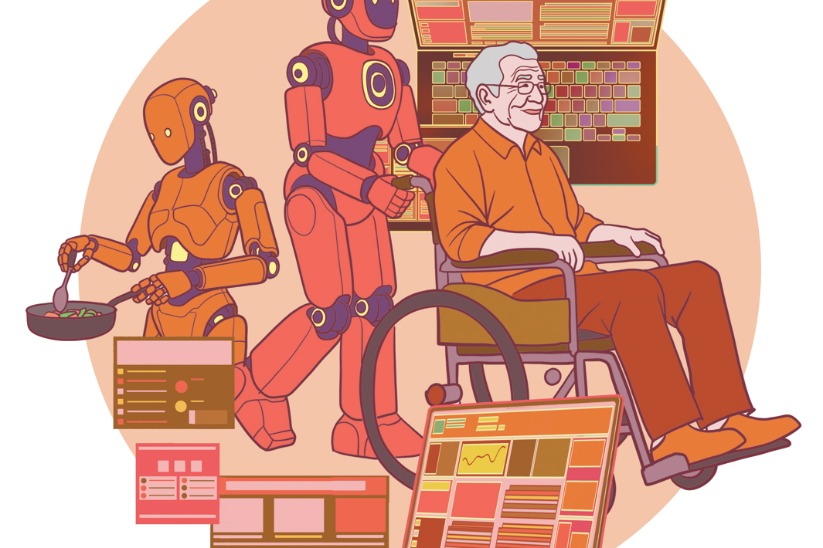Empowering the future


Global cooperation in AI will help promote industrial transformation and bring benefits to all
"Artificial Intelligence +" is no longer just an idea. Fueled by rapid technological advances, evolving regulatory frameworks and booming market demand, it has now become a central engine driving industry transformation in China and powering the nation's high-quality economic growth.
First, the AI industry is expanding rapidly and emerging as a new catalyst of growth. In 2024, China's core AI sector surpassed 700 billion yuan ($98.49 billion), up 21 percent year-on-year. The growth outpaces GDP expansion, highlighting AI's role as a key driver of the digital economy.
Second, a robust AI business ecosystem is taking shape, led by top-tier and unicorn companies. By the end of 2024, more than 4,800 AI-related companies operated nationwide, creating a diverse mix of tech giants, unicorns, and small- and medium-sized innovators. China's investment and financing in AI totaled $7.6 billion in 2024, second only to that of the United States, underscoring China's leadership in the global AI capital market. At the same time, AI applications are seeing more in-depth adoption, delivering tangible results in key sectors.
Third, AI is steadily penetrating various sectors and being widely applied. Financial services show the highest adoption rates, with applications such as intelligent risk control, quantitative trading and robo-advisers becoming common practice. AI has helped lower nonperforming loans by 1.2 percentage points and boosted insurance claim efficiency by 40 percent. In manufacturing, industrial robots and predictive maintenance are driving significant productivity gains. In healthcare services, AI-assisted diagnostics and telemedicine are helping mitigate the uneven access to medical care across the country.
Finally, China is seeing a growing AI talent pool and research capabilities. In 2024, the country had about 450,000 AI researchers, up 18 percent year-on-year, with those holding doctorates or higher credentials accounting for 20 percent, a sign of steadily rising expertise.
Despite the encouraging momentum, China's "AI+" development still faces several challenges.
First, China's AI sector is making significant strides but still faces critical technology bottlenecks. China depends heavily on imported high-end AI chips and foundational algorithm frameworks. Domestic versions of advanced chips lag behind top global players by roughly two generations in computing density and energy efficiency, preventing them from supporting large-scale model training.
For deep-learning frameworks, foreign platforms such as Tensor-Flow and PyTorch dominate 80 percent of the market, leaving domestic alternatives far behind in ecosystem maturity, developer adoption and the capacity to support complex, industrial-scale applications.
Second, AI adoption in industries is still limited and often difficult. In traditional manufacturing and service industries, AI penetration has reached 25 percent, still far behind more digital-savvy sectors such as the internet and finance, and well below US levels, where adoption stands at 42 percent in manufacturing and 38 percent in services.
Fewer than 15 percent of SMEs have implemented AI, compared with over 60 percent of large companies. Barriers, including high implementation costs, lack of technical teams and poor adaptation to specific scenarios, result in low returns on investment.
Third, the talent structure is imbalanced, with a shortage of top-tier experts and interdisciplinary professionals. The supply-demand ratio for leading AI scientists and algorithm architects is 1:9. China accounts for 18 percent of the world's highly cited AI researchers, well below the US' 52 percent. China lacks senior talents in areas such as large-model training and AI chip design.
There is also a prominent shortfall in interdisciplinary talents who understand both the fundamentals of AI and the operational logic of a traditional industry. In 2024, only about 40,000 students were enrolled in AI relevant programs, far below what the market needs.
Fourth, underutilized data resources and widespread data silos and barriers are holding back AI training and development. For Chinese enterprises, large amounts of production and operational datasets sit idle due to inconsistent formats, poor labeling and security concerns, while European companies have achieved an average 62 percent of data utilization rate through standardized data management systems.
In China's public sector, from public services to healthcare and transport, data sharing has risen to 25 percent, still well below Singapore's 78 percent and Canada's 65 percent, hindering data supplies for AI model training.
Global cooperation will be key to advancing AI, and progress hinges on four key areas.
First, the country needs to build international R&D alliances to tackle core technology challenges. This means creating multinational research groups, launching global scientific projects focused on AI chips and algorithms, and sharing results. At the same time, it is necessary to promote open-source compatibility, and harmonize AI frameworks and computing through organizations, such as the International Organization for Standardization and the International Electrotechnical Commission, to help prevent fragmented ecosystems.
Second, multinational demonstration projects should be launched to speed up real-world adoption. It is advisable to establish a world AI cooperation organization to help develop pilot programs in manufacturing, healthcare and other key sectors. For example, Southeast Asia could jointly develop "AI+smart manufacturing" parks to support the digital transformation of SMEs. At the same time, developing countries need to be supported with technology transfer, computing resources and talent training to help narrow the digital divide.
Third, countries should collaborate to develop global AI talents. This means building international joint laboratories and scholarship programs, expanding scholar exchanges and overseas education programs, promoting mutual recognition of AI credentials, and creating unified assessment standards to encourage the free flow of top talents.
Finally, the United Nations' leadership in AI governance should be upheld. International governance bodies should be established to drive consensus on ethical principles and algorithmic transparency. The international community should advance collaborative research, co-develop ecosystems and make rules through extensive consultation to make AI a global public good that benefits humanity.
Yang Zekun is a research fellow at the National Academy of Development and Strategy at Renmin University of China. Yang Yiyong is a senior research fellow at the Academy of Macroeconomic Research. The authors contributed this article to China Watch, a think tank powered by China Daily.
The views do not necessarily reflect those of China Daily.
Contact the editor at editor@chinawatch.cn.


































